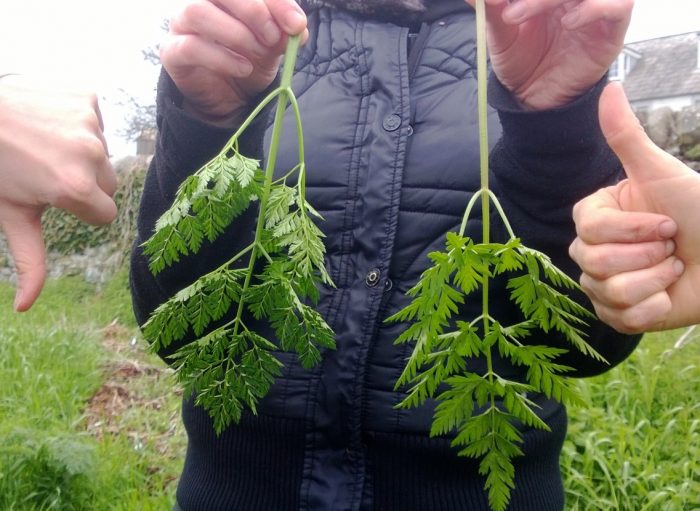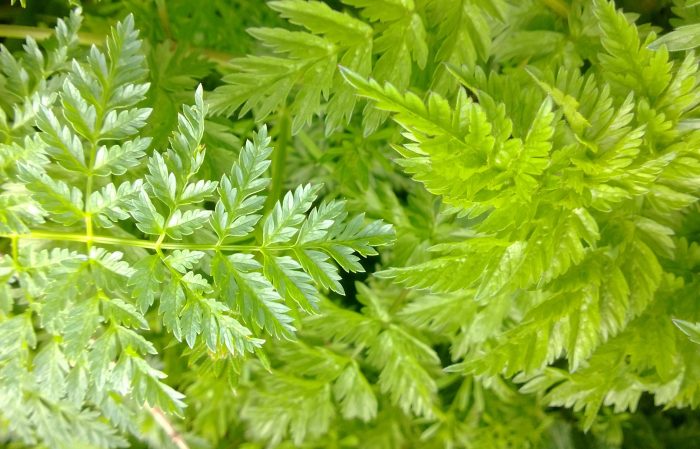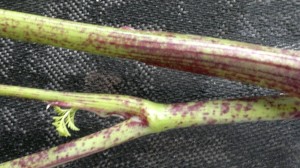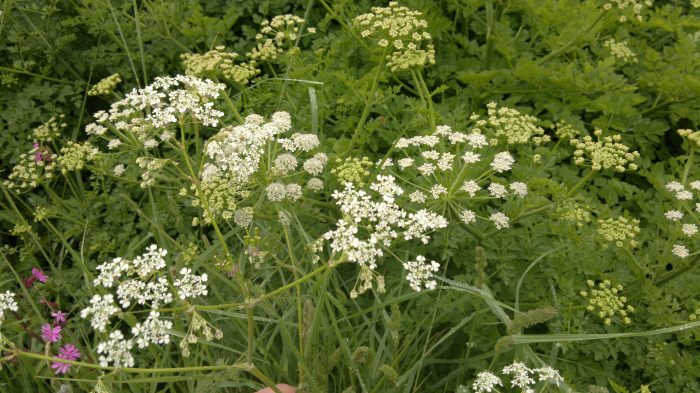Cow parsley – identification, edibility, distribution, comparison with Hemlock
Anthriscus sylvestris
Cow parsley AKA Wild chervil, and sometimes referred to as Queen Anne’s Lace, though several plants in the apiaceae family get this name, including wild carrot (daucus carota). Its not clear if this has arisen from misidentification, or just regional differences, but certainly demonstrates the usefulness of binomial names for precise discussion of wild species.
- Edibility – Leaves 3/5, Young flowering stems (peeled) 4/5, Flowers 3/5, Seeds (while young, tender and green) 3/5
- Identification – 1/5 – Take extreme care if you intend to eat cow parsley. It is a member of the carrot family, many of which share similar umbeliferous white inflorescences and several times pinnate leaves. This includes deadly species such as hemlock and hemlock water-dropwort, which can grow alongside it. Always confirm your identification against several key features and discard if you are not 100% of what you have. Read more: An Introduction to the Carrot/Apiaceae Family for Foragers.
- Distribution – 5/5 – Extremely common
- Season – basal leaves best Jan – May, Shoots April – May (they have quite a short window of succulence)
- Habitat – roadside verges, wood edges, river banks, wild meadows
Cow parsley is the predominant roadside umbelifer in much of the UK from March through to June, when its delicate, nodding white flower umbels adorn nearly every rural roadside in the UK like fine living lace – hence the old name of Queen Anne’s Lace (though in different regions, different umbellifers get given this name – especially wild carrot (Daucus carota), on account of its single red flower in the middle of each umbel, representing the blood of Queen Anne). By the time they have flowered however, the leaves are past their best for eating, though still palatable as a pot herb.
The young basal leaves taste, as you might expect, like a strong version of parsley, and can be used in similar ways.
Be extremely cautious if you are trying to identify cow parsley from its basal leaves alone. I recommend familiarising yourself with a nearby patch through at least one full growing season before even thinking of eating any. Even then proceed with extreme care, as the leaves are very similar to poison hemlock (conium maculatum).

Hemlock, Left v Cow Parsley Right. Would you stake your life on recognising the difference from these leaves alone?
Identification of any member of the carrot family should be based on a minimum of three clearly identifiable features. I take you through this process and how to develop confidence identifying more members of this challenging family in my Introduction to the Carrot Family for Foragers. I suggest you read it to get a fuller idea of the benefits and dangers of this extremely prolific plant family.
I suggest that, unless you are a botanist, you initially ignore both leaf and flower structure when trying to distinguish cow parsley from poison hemlock. What I look for to feel sure I have cow parsley are:
- Cow parsley is hairy (very fine, very short, velvet-like hairs, sometimes hard to see but always giving leaf stems and flowering stems a rough feel). Hemlock is entirely free of hairs – they will feel smooth. This is your most useful comparison, but don’t make it the only one!
- Cow parsley has U shaped leaf stems (or more like a D on its side). Hemlock has rounded leaf stems, though these do form sheaths near their base.
- Cow parsley leaf stems and flowering stems tend to be greenish – purple, sometimes entirely purple, but they are NEVER blotchy. Hemlock flowering stems are blotched with purple, though the blotches can be minimal, occasionally absent, especially when young.
- Cow parsley leaves smell of parsley if you crush them in your fingers. Hemlock leaves smell a bit unpleasant – a little acrid/ammoniac (often described as “of mouse pee”, though I doubt many people know the smell of mouse pee nowadays!). Clearly smell is subjective, but it can be a useful part of your ID toolkit given some practice and experience.

One of these leaves is hemlock, the another cow parsley. Don’t play Russian roulette with plant ID! Look for more features!
For me, the real delight of cow parsley comes over a short 2 to 3 week window (around the second half of April in SW Scotland) when the young flowering stems rapidly push their way up from the basal leaves. These are crisp and juicy after light peeling (they peel very readily, eager to give up their gifts!). They are one of my favourite hedgerow snacks in late April. Most plants produce a few of these stems, so its only manners to take just one from each plant you visit. They are a really great vegetable in the kitchen too – steamed, stir-fried, added to salads or as a delightfully crisp crudite…maybe for dipping in wild garlic pesto..? Cheffy types could certainly pipe nice things into their hollow tubes.

Cow parsley stem. Note the HAIRY (like velvet) , GROOVED flowering stem that while having some purple colouration, is NOT BLOCHY.
Related Pages:





30 Comments
Just tried cow parsely, really love it! It now turns to be my favourite wild food now. I use the whole plant, including the root, I hv to say that the root is very good, the taste is btwn potato and carrot. I highly recommd it! The very important thing is learn to know the thing you digged out from the earth is not Hemlock, Hemlock has very ugly looking and bad smelling, you will never forget it once you hv met them.
Are the roots best cooked ?
Also I found this note:
“The roots contain toxic compounds that could be dangerous if taken during pregnancy, when breastfeeding, or when used for specific complaints in certain sensitive individuals. Seek medical advice before use.” at:
http://www.eatweeds.co.uk/cow-parsley-anthriscus-sylvestris
I don’t eat the root, and there doesn’t seem to be much useful information on its historical usage, though it doesn’t seem to be doing Y.L. any harm!. Robin’s website (Eat Weeds) generally errs on the side of extreme caution, as does Plant’s For a Future, often emphasising safety warnings for which there is little or no real evidence, just occasional mentions online. This is entirely understandable, but where there is no helpful information, I tend to just not list that part/species as edible on my website.
Hi there,
I thought Queen Anne’s Lace was another name for Wild Carrot…..not Cow Parsley?
Kind Regards,
Andrea.
Quite a lot of the carrot family get given this name. Personally I think it best suits wild carrot for the red (blood) flower in the middle of the umbel, but it certainly also gets widely applied to cow parsley
Thanks for the feedback Mark,
How confusing!
Kind Regards,
Andrea.
True but Cow Parsley is mainly referred to as wild chervil, which I am currently hunting for in my area, not Queen Annes Lace “AKA” Wild Carrot. It seems everyone forgets to about the Queen Annes lace seed heads called “nests” Most collect the seeds when brown, put them into a chopper, (I use Magic Bullet) to make the most wonderful seasoning for all kinds of foods and meats. It has a much better smell and flavor than the leaves or roots really (In my own humble opinion) and much easier to Identify Hemlock flowers to me seem tight ball heads where wild chervil doesn’t more soft and loose, and the queen Annes flower in one big flower like a lace patch with a dot of red in the center. Perhaps pictures of these too would help in Identification?
I knew Cow Parsley as Queen Anne’s Lace as a child in rural Lincolnshire. Thanks for this ID guide, Mark. Very helpful.
Queen Anne’s Lace is a different plant altogether from Cow Parsley–at least here in the states.
Queen Anne’s Lace is regularly used for several different members of the carrot/apiaceae family (including wild carrot, daucus carota), and this does vary regionally. If in doubt, use binomial names!
That’s what the author has been taking pains to say, duh.
Hemlock Water-Dropwort flower heads look a bit like exploding fireworks I think.
I have heard that there are other very similar plants to cow parsley that are not hemlock that are also very poisonous.
My question is, do some of the poisonous ones also have hairs on the stalks, or do hairs on stalks of something that looks like cow parsley mean that it’s probably edible m
Thanks
Please check out my Forager’s Guide to the Carrot Family for the lowdown on this:
your description seems to be all good to me, this is a perfect match where i coming from in the West Dunbartonshire area of Scotland
Excellent information, thanks! If you are stir frying cow parsley flower stalks, do you need to peel them first?
Yes, they can be a bit stringy if you don’t. 🙂
thanks Phil.
Yes I think this name was because of a story that Queen Anne pricked her finger on the needle when lacemaking and the droplet of blood fell upon the lace. Hence the lovely name. The other plants without the red flower aren’t usually called Queen Anne’s lace here according to senior locals here in Cornwall.
Bob, i too had heard that story, although the name is very rairly used here. Scottish Borders
Hi! I found this excellent blog post while searching for information on the edibility (or other uses!) of cow parsley seeds. Your “1/5” rating for the seeds at the top of this post indicates you may know something about this? It seems like they could potentially be a great resource, if useable.
After harvesting a lot of the green seeds this June, I’ve revised my estimation of them upwards! They have a nice parsley/carrot kick – great for adding to pickles, salad dressing etc.
I have a photo of a Cow Parsley with purple ball looking blooms…do they then turn white or did I misidentify the plant?
Very hard to say without seeing the image…
There’s a pink form which you can buy at Chiltern Seeds.
I found a very hairy stem fern that has the “rhubarb groove”and looks and smells like parsley but is slightly more fine than cows parsley … It’s more hairy and the leaves are slightly more delicate and prettier thanks
Sorry Bonne, I rarely guess at ID’s from photos, let alone vague written descriptions like this. More about this here:
I saw some parsley looking plant near some water stream in San Diego California. I was with my kids there immediately I told them it was parsley and I cut some and I chew on it. It smelled like parsley and it tasted like it but I really never thought that it could be some poisoning plant looking like parsley. It has been an hour I’m still ok. But I’m worried. I have a picture of and it looks like parsley but with purple lines, not dots but lines. It doesn’t look like anything you guys are presenting in any video or images about the Queen Ann flower plant or hermlock.
Good luck, and tell your kids never to do that.
Here is a cautionary tale. Many years ago ( in 1955 or thereabout) my father and I were walking in the surrey hills when he stopped and cut a stem from a stand of cow parsley and proceeded to fashion a whistle from it with his pen knife. He passed it to me and I set about trying to get a tune from it. Not long after that I felt a numbness and swelling in my lips, and my father realised his error, he had cut the stem from hemlock. I suffered no permanent injury, probably because I had not swallowed any of it, but my father was mortified that he had made such a terrible mistake. I don’t think we ever mentioned it to my mother!